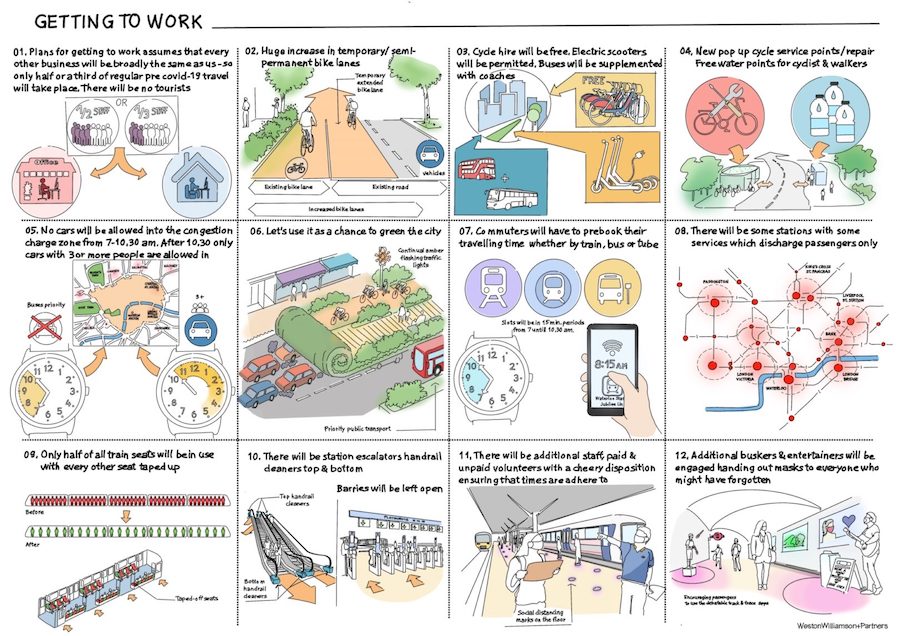Transportation / Service redesign
Proposal outlines how the work commute might adapt to COVID-19
By Andrew Sansom | 18 May 2020 | 0
Urban design and transport consultancy Weston Williamson + Partners has put together a proposal plan for how its employees – and those of other businesses – might make the transition from home working to returning to their employers’ offices.
Describing the strategy on the company’s website, founding partner Chris Williamson, said: “We have found that we can function with home working but that there are advantages to working together and areas of studio life that we miss. We need to blend the two ways of working and recognise that in the future, this may become the new normal.”
Key to work activity returning to its studio in London will be understanding how its employees can safely get to work. When planning for this, he says, the firm has worked on the assumption that other businesses will have employees travelling to work but only with a proportion of their workforce doing so, in order that social distancing in the workplace is maintained.
He points to a survey the firm carried out last year on commuter attitudes in 10 global cities, with the results incorporated into its return-to-work strategy. The firm has also used knowledge of how its own staff commute to work, which it has gained as part of regular staff commuting surveys.
“We know how long our staff travel for and what modes they use,” says Williamson. “We also know who is within reasonable walking or cycling zones.”

The proposal is broken down as follows:
- No cars will be allowed into the congestion charge zone from 7.00-10.30. After 10.30 only cars with three or more people will be allowed. A new car-sharing app would make this possible and reflects existing schemes in other cities across the globe.
- To maintain safe social distancing, buses will be supplemented with coaches, with the various bus companies working together to address capacity on the most popular routes.
- More space will be given to cycling and walking and greening the city.
- Cycle hire will be free.
- Electric scooters will be permitted, with legislation quickly changing to allow this throughout cities.
- Commuters will have to pre-book their travelling time whether by train, bus or tube. Slots will be in 15-minute periods from 7.00 till 10.30 for the morning peak and 16.00 till 19.00 for the evening. Already a feature on long-distance journeys, this will help manage demand on the commuter routes and allow space on the trains for social distancing.
- Encouraging commuters to stagger their start and end times will help manage demand and continue to encourage the trend for flexible working already in progress with the move to home working.
- Additional staff will be needed at stations to manage passengers. Staff will be redeployed for queue management and offering guidance and information.
- Passengers will need to be managed in groups into the station, onto the platforms and onto the trains, employing methodologies from sports and event crowd management.
- Additional buskers and entertainers will be engaged, handing out masks to anyone who might have forgotten theirs and encouraging passengers to use the track and trace app currently being trialled by the UK Government.
- Cleaning will be paramount, with escalator handrail cleaners top and bottom, and barriers will be left open to avoid unnecessary delays and crowding.
- There will be some stations that discharge passengers only; for example, where stations are close together. On quieter stations, alternate doors on trains and tubes would allow passengers on or off with areas on the platform designated accordingly.
These measures, said Williamson, need to be implemented thoughtfully with an understanding of how they fit with the current design of the station. Simple and elegant wayfinding will also be key to avoid passenger confusion and maintain a quality of commute during the pandemic.
“Thinking further ahead, we should consider that this is not a one-off hiatus,” he said. “We should plan for this happening again, next time maybe worse. We should plan our transport and our cities and our economy to build in this resilience – and to give us a choice of where to live, work and relax.
“If we plan properly it will work, it could even be fun, and will make the world a better place.”
Organisations involved
